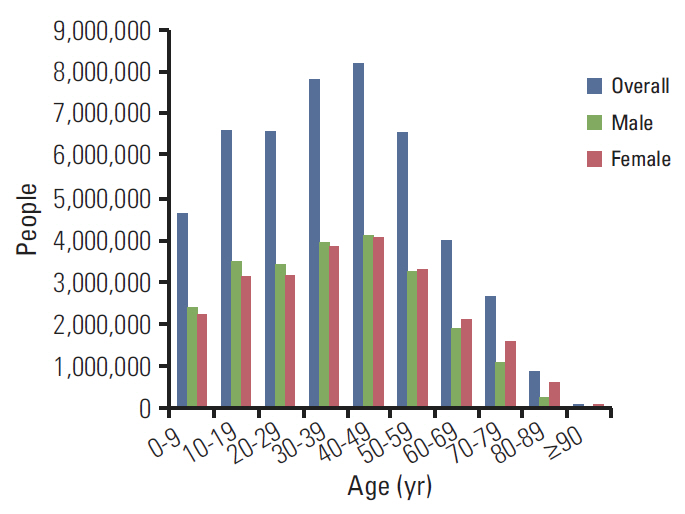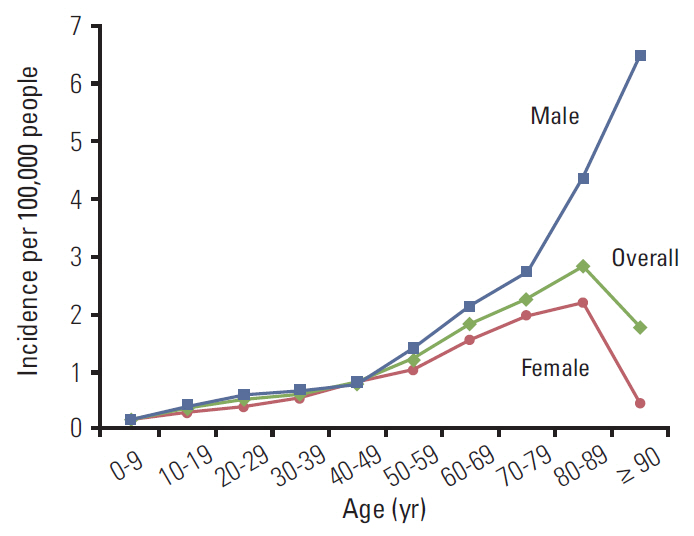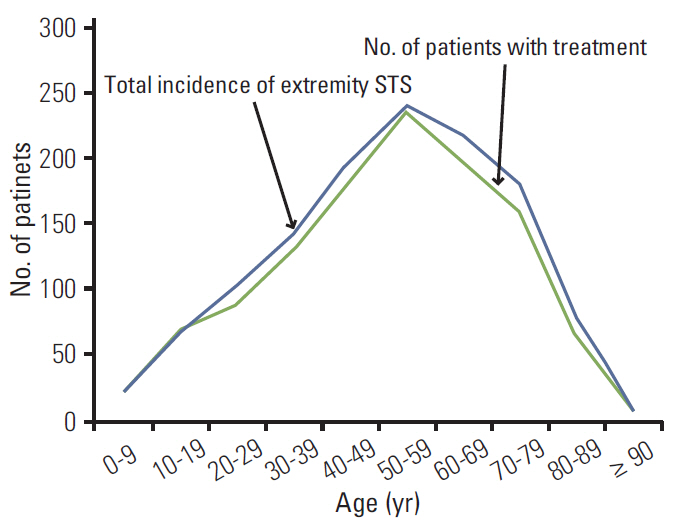Cancer Res Treat.
2015 Oct;47(4):575-582. 10.4143/crt.2014.047.
Incidence and Treatment Pattern of Extremity Soft Tissue Sarcoma in Korea, 2009-2011: A Nationwide Study Based on the Health Insurance Review and Assessment Service Database
- Affiliations
-
- 1Department of Orthopaedic Surgery, Seoul National University Hospital, Seoul, Korea. hik19@snu.ac.kr
- 2Musculoskeletal Tumor Center, Seoul National University Cancer Hospital, Seoul, Korea.
- 3Department of Orthopaedic Surgery, Gachon University Gil Hospital, Incheon, Korea.
- KMID: 2403374
- DOI: http://doi.org/10.4143/crt.2014.047
Abstract
- PURPOSE
We conducted a nationwide study to assess the incidence and treatment patterns of extremity soft tissue sarcoma (STS) in South Korea.
MATERIALS AND METHODS
The nationwide incidence and treatment patterns of extremity STS were assessed using two nationwide databases, the Korea National Cancer Incidence (KNCI) database and the Health Insurance Review and Assessment Service (HIRA) database.
RESULTS
A total of 1,236 patients were newly diagnosed with extremity STS during the 3-year study period, from 2009 to 2011. The annual incidence of extremity STS in the Korean population was approximately 0.9 per 100,000 people with a male bias that increased with age and was especially pronounced amongst individuals aged > 80 years. Approximately 7% of patients did not receive any treatment, and surgical excision was performed for 85% of those who were treated.
CONCLUSION
This is the first nationwide study of the incidence and treatment patterns of extremity STS in Korea using two national databases (KNCI and HIRA), which include the entire Korean population. The results of this study may be useful for future planning and management of STS, at the national level.
Keyword
MeSH Terms
Figure
Cited by 1 articles
-
Characteristics and Treatment Patterns of Patients with Advanced Soft Tissue Sarcoma in Korea
Hyo Song Kim, Chung Mo Nam, Suk-Yong Jang, Sun Kyu Choi, Minkyung Han, Seonmin Kim, Maria Victoria Moneta, Sae Young Lee, Jae Min Cho, Diego Novick, Sun Young Rha
Cancer Res Treat. 2019;51(4):1380-1391. doi: 10.4143/crt.2018.476.
Reference
-
References
1. Boring CC, Squires TS, Tong T. Cancer statistics, 1993. CA Cancer J Clin. 1993; 43:7–26.
Article2. Sondak VK. Sarcomas of bone and soft tissue. In : Greenfield LJ, Mulholland MW, Oldham KT, editors. Surgery: scientific principles and practice. 3rd ed. Philadelphia: Lippincott Williams & Wilkins;2000. p. 2258–80.3. Parsons HM, Habermann EB, Tuttle TM, Al-Refaie WB. Conditional survival of extremity soft-tissue sarcoma: results beyond the staging system. Cancer. 2011; 117:1055–60.4. Levi F, La Vecchia C, Randimbison L, Te VC. Descriptive epidemiology of soft tissue sarcomas in Vaud, Switzerland. Eur J Cancer. 1999; 35:1711–6.
Article5. Ross JA, Severson RK, Davis S, Brooks JJ. Trends in the incidence of soft tissue sarcomas in the United States from 1973 through 1987. Cancer. 1993; 72:486–90.
Article6. Schuurman B, Meyer S, Cuesta MA, Nauta JJ. Increasing frequency of soft tissue sarcomas in The Netherlands. Ned Tijdschr Geneeskd. 1992; 136:1556–60.7. Storm HH. Cancers of the soft tissues. Cancer Surv. 1994; 19-20:197–217.8. Toro JR, Travis LB, Wu HJ, Zhu K, Fletcher CD, Devesa SS. Incidence patterns of soft tissue sarcomas, regardless of primary site, in the surveillance, epidemiology and end results program, 1978-2001: an analysis of 26,758 cases. Int J Cancer. 2006; 119:2922–30.
Article9. Wibmer C, Leithner A, Zielonke N, Sperl M, Windhager R. Increasing incidence rates of soft tissue sarcomas? A population-based epidemiologic study and literature review. Ann Oncol. 2010; 21:1106–11.
Article10. Lewis JJ, Brennan MF. Soft tissue sarcomas. Curr Probl Surg. 1996; 33:817–72.
Article11. Shin HR, Won YJ, Jung KW, Kong HJ, Yim SH, Lee JK, et al. Nationwide cancer incidence in Korea, 1999~2001; first result using the national cancer incidence database. Cancer Res Treat. 2005; 37:325–31.
Article12. Health Insurance Review and Assessment Service. Health insurance statistics yearbook: 9th annual publication [Internet]. Seoul: National Health Insurance Service;c2013. [cited 2013 Sep 1]. Available from: http://www.hira.or.kr.13. Park YT, Yoon JS, Speedie SM, Yoon H, Lee J. Health insurance claim review using information technologies. Healthc Inform Res. 2012; 18:215–24.
Article14. Fritz A, Percy C, Jack A, Shanmugaratnam K, Sobin L, Parkin DM. International Classification of Disease for Oncology. 3rd ed. Geneva: World Health Organization;2000.15. Korea Central Cancer Registry. International Classification of Diseases for Oncology. 3rd ed. (Korean version). Goyang: National Cancer Center;2003.16. World Health Organization. Manual of the international statistical classification of diseases, injuries, and causes of death. 10th revision. Geneva: World Health Organization;1992.17. Gong HS, Oh WS, Chung MS, Oh JH, Lee YH, Baek GH. Patients with wrist fractures are less likely to be evaluated and managed for osteoporosis. J Bone Joint Surg Am. 2009; 91:2376–80.
Article18. Demetri GD, Antonia S, Benjamin RS, Bui MM, Casper ES, Conrad EU 3rd, et al. Soft tissue sarcoma. J Natl Compr Canc Netw. 2010; 8:630–74.
Article19. Statistics Korea. Estimates of future population 2010-2060 [Internet]. Daejeon: Statistics Korea;c2012 [cited 2012 Sep 15]. Available from: http://kosis.kr. 2010.20. Sampo MM, Ronty M, Tarkkanen M, Tukiainen EJ, Bohling TO, Blomqvist CP. Soft tissue sarcoma: a population-based, nationwide study with special emphasis on local control. Acta Oncol. 2012; 51:706–12.21. Brennan MF. Management of extremity soft-tissue sarcoma. Am J Surg. 1989; 158:71–8.
Article22. Lawrence W Jr, Donegan WL, Natarajan N, Mettlin C, Beart R, Winchester D. Adult soft tissue sarcomas: a pattern of care survey of the American College of Surgeons. Ann Surg. 1987; 205:349–59.23. Kang YP, Cho MH. Elderly population distribution and it's evolution in Korea: 1980, 1990, 2000. J Korean Cartogr Assoc. 2005; 5:1–5.24. Bauer HC, Trovik CS, Alvegard TA, Berlin O, Erlanson M, Gustafson P, et al. Monitoring referral and treatment in soft tissue sarcoma: study based on 1,851 patients from the Scandinavian Sarcoma Group Register. Acta Orthop Scand. 2001; 72:150–9.
Article25. Kang S, Han I, Lee S, Kim W, Kim H. Clinicopathological characteristics and prognostic factors of T1 (≤ 5 cm) soft tissue sarcoma: a comparative study with T2 (> 5 cm) soft tissue sarcoma. Eur J Surg Oncol. 2014; 40:406–11.
- Full Text Links
- Actions
-
Cited
- CITED
-
- Close
- Share
- Similar articles
-
- Update on the Management of Extremity Soft Tissue Sarcoma
- Infantile Extraosseous Ewing's Sarcoma in the Left Arm: A Case Report
- Acute Myocarditis in Children: a 10-year Nationwide Study (2007–2016) based on the Health Insurance Review and Assessment Service Database in Korea
- Extraskeletal Neoplasm Resembling Ewing's Sarcoma: Report of one case
- Health Inequities in Cancer Incidence According to Economic Status and Regions Are Still Existed Even under Universal Health Coverage System in Korea: A Nationwide Population Based Study Using the National Health Insurance Database




